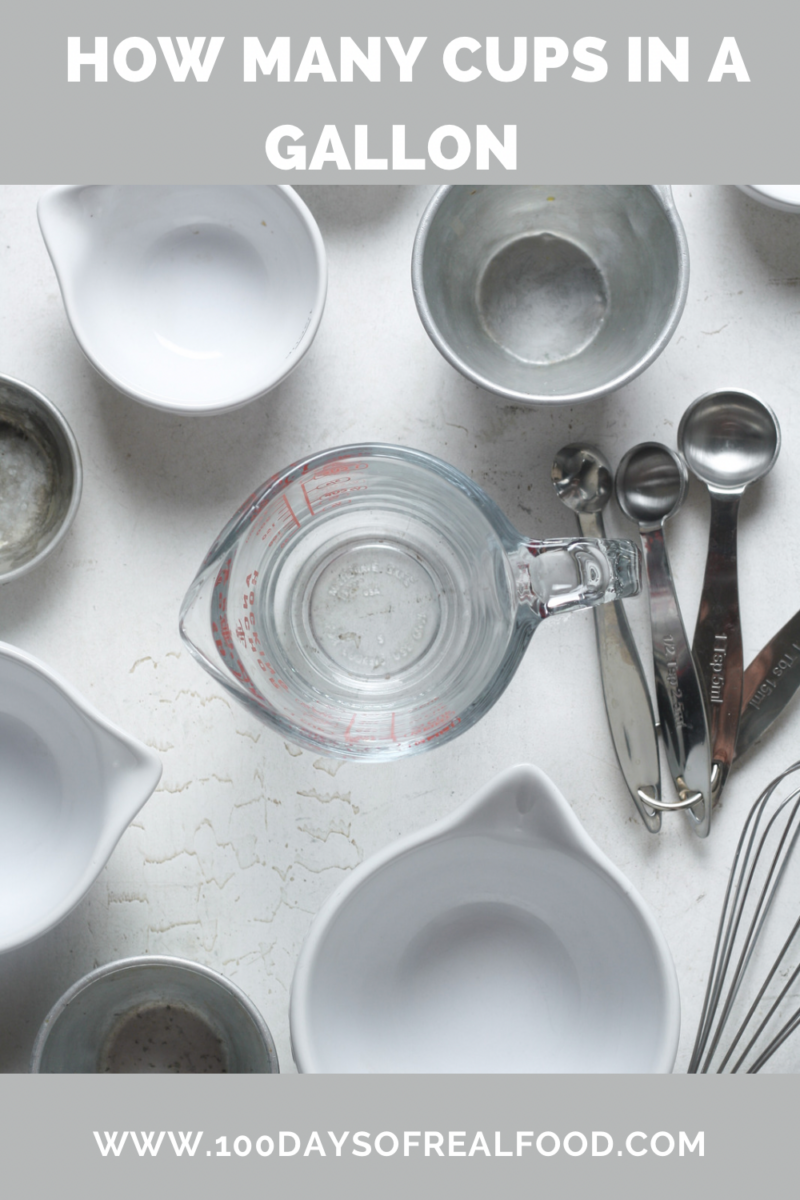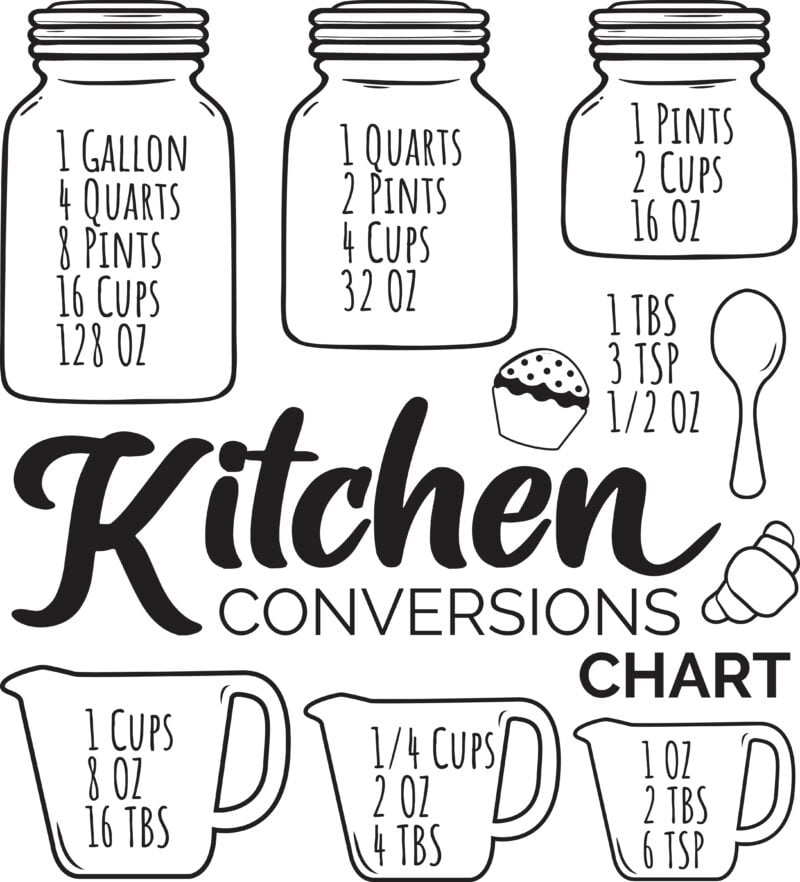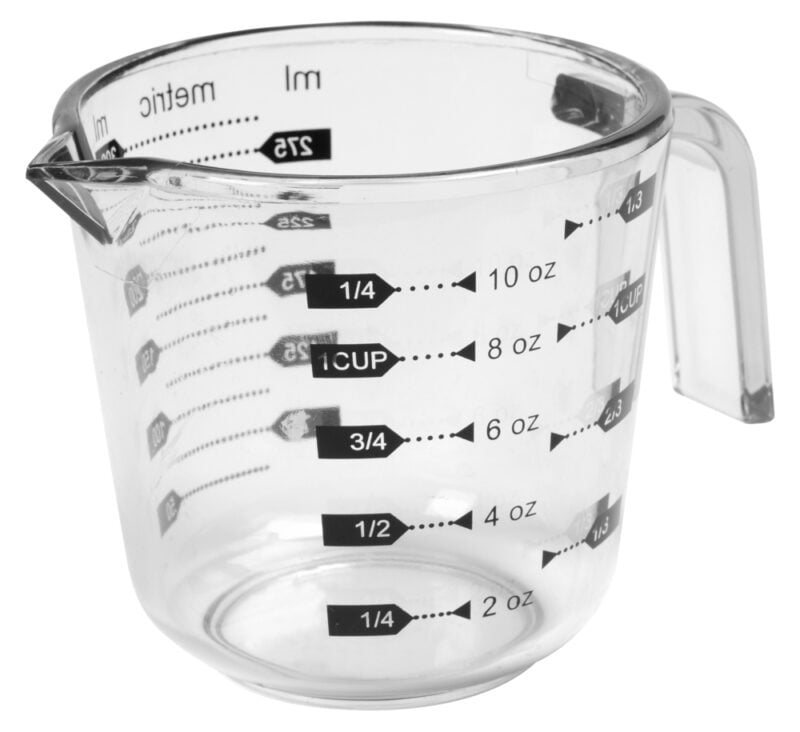How Many Cups in a Gallon ⋆ 100 Days of Real Food
Knowing how many cups in a gallon is handy when it comes to cooking, baking, or even just measuring liquids.
Whether as part of preparing a big meal for a gathering or simply trying to understand measurements, this knowledge is a key part of cooking.
This article contains details of how many cups are in a gallon, explanations about what cups and gallons are, and helpful conversion tables.

What is a Cup?
The standard cup is equivalent to 8 fluid ounces (240 milliliters) and is often called the “U.S. customary cup.”
In American cooking, a cup is considered a standard volume measurement unit.
It provides a consistent way to quantify ingredients. This is whether they are liquids like water, milk, or oils or dry ingredients like flour, sugar, or grains.
Having uniform and precise measurements in baking and cooking is important for great results in a recipe’s texture and taste.
Cups are very easy and versatile to use in the kitchen. They are great when scaling recipes up and down and need very little conversion technique. If you need to adjust the serving size of a recipe, you can multiply or divide the cup measurements.
It is important to note that the US customary cup differs from the one used in the UK (and other countries using the metric cup). The metric cup is slightly larger than the imperial cup and 250 milliliters.
What is a Gallon?
In the United States, we have two main types of gallons that you might come across when cooking.
The first one is called the US liquid gallon. This unit is all about measuring liquids like milk, water, or oil for frying. It is equivalent to 128 smaller cups of liquid, roughly 3.785 liters.
Convert Gallons to Cups
Converting gallons to cups is straightforward. One U.S. liquid gallon equals 16 U.S. customary cups, making it a simple conversion.
For example, if you have 2 gallons of water, you would have 32 cups of water (2 gallons x 16 cups/gallon = 32 cups).
The process of converting gallons to cups is a simple mathematical calculation. In the United States, where the US customary system is used, the relationship between these two units of volume is clear-cut.
Table with Conversions from Gallons to Cups
| Gallons | Cups |
| 1 | 16 |
| 2 | 32 |
| 3 | 48 |
| 4 | 64 |
| 5 | 80 |
Table with Conversions from Cups to Gallons
| Cups | Gallons |
| 1 | 1/16 |
| 2 | 1/8 |
| 3 | 3/16 |
| 4 | 1/4 |
| 5 | 5/16 |

Equipment for Measuring
Accurate measurements are very important in cooking and baking. In terms of measuring cups and gallons, here is what you need to know.
Cooking utensils and equipment usually do not measure gallons directly. This is because gallons are a big unit of volume, and cooking utensils are generally designed to measure smaller volumes, like cups, tablespoons, or milliliters.
To measure gallons accurately in a cooking context, you would typically use a separate liquid measuring container, such as a gallon-sized pitcher or container.
These specialized cups are designed to measure liquids precisely. They come in various sizes, usually ranging from 1 cup to 4 cups, and have easy-to-read markings on the side.
For dry ingredients like flour, sugar, and grains, dry measuring cups are a must-have.
These cups come in various sizes (1/4 cup, 1/3 cup, 1/2 cup, 1 cup, etc.) and are designed for leveled scoops. Their straight edges allow you to level off excess ingredients for precise measurements.
Imperial System Versus Metric System
The United States mainly utilizes the Imperial system for measuring various quantities, encompassing volume measurements like cups and gallons.
The Imperial System has its roots in the British Empire. It is also used in some parts of the United States. It started to become standard in the 19th century. This happened when the British wanted to standardize their measurements for trade and commerce.
They created units like the inch, foot, pound, and gallon, which were based on older, less precise measurements.
It is important to note that the British later adopted the Metric system, which they use today.
In cooking, you should use Imperial units when a recipe calls for a cup of flour or a teaspoon of salt.
In most other countries, the Metric system is used. The metric system uses liters as the standard unit for liquid volume.
The Metric System, on the other hand, originated in France during the late 18th century. The French wanted a more scientific and consistent way to measure things. They came up with units like the meter, gram, and liter, which are all based on powers of ten, making conversions between them much easier.
In the culinary world, the Metric System is widely used in many countries around the world. You might find a recipe that asks for 250 grams of sugar or 500 milliliters of water. It’s simpler and more precise for measuring ingredients.
Getting to know both systems can be helpful, especially if experimenting with recipes from diverse international cuisines is something you love to do.

Frequently Asked Questions (FAQs)
There are 1/16th (0.0625) of a gallon in one cup.
There are 16 cups in one gallon.
One gallon of butter would be equivalent to 16 cups of butter.
One gallon of water is equal to 16 cups of water.
One gallon of flour would also be equal to 16 cups of flour.
Gallons can be measured in both the U.S. liquid gallon and the U.S. dry gallon, depending on the ingredient being measured. The conversion between the two varies slightly.
Flour can be measured using dry measuring cups. The most accurate method is to fluff the flour in the container, spoon it into the measuring cup, and then level it off for precise measurements.
You May Also Enjoy
If you enjoyed this how many cups in a gallon post, please leave a rating and comment! For more inspiration, check out my Facebook, Instagram, and Pinterest. For 5 free weekly meal plans and more free resources, sign up to receive my free newsletter!
Enjoy this comprehensive guide for converting cups to gallons!




